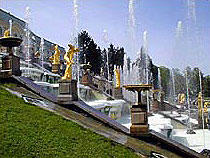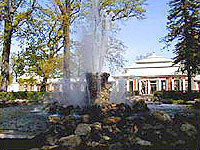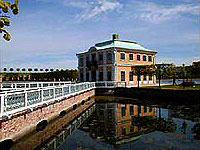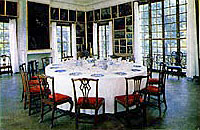Peterhof
 Petrodvorets is a place to visit during the summer when the fountains are operating. In good weather it is well worth spending an entire day here, enjoying the various palaces, the parks, and the sea view.
Petrodvorets is a place to visit during the summer when the fountains are operating. In good weather it is well worth spending an entire day here, enjoying the various palaces, the parks, and the sea view.
The history of Petrodvorets (called Peterhof until 1944) begins in 1704 when Peter I built a wooden house on the Gulf while overseeing the construction of the nearby Kronstadt Fortress.
In 1713 he began transforming the area into an imperial residence. The palace was inaugurated in 1723 and later expanded by Empress Elizabeth. Petrodvorets is also a monument to Soviet reconstruction as the place was looted and practically razed to the ground by Nazi troops.
The Grand Palace (Bolshoi Dvorets) dominates the estate. Similar in scale to Catherine's Palace in Pushkin, it is filled with lavish rooms and galleries.
 Most of the palace was built during Elizabeth's time - note her big bed. After Elizabeth, most of the emperors and empresses used the palace for functions and official purposes, choosing to live elsewhere.
Most of the palace was built during Elizabeth's time - note her big bed. After Elizabeth, most of the emperors and empresses used the palace for functions and official purposes, choosing to live elsewhere.
The rooms are standard palace material: gilt and mirrors, "Chinese" rooms (decorated in the neo-Asiatic style fashionable in 18th century high society), thematic rooms (like the Chesma Hall with its endless artistic renditions of the Russian victory over the Turks at Chesma Bay in 1770), a room filled with portraits of little girls, fancy drawing rooms and bedrooms, and so on.
In theory you must have the palace shown to you by a museum guide, so if you're on your own you'll end up getting hooked with a group that you can ditch as soon as you get inside.
The exit is craftily laid out so that you have to pass through about five gift shops to get back to the park.
The estate includes several other mini-museums of interest. The outwardly-modest Monplaisir Palace, which Peter I preferred to the Grand Palace, has a nice sea view and several interesting rooms, such as the State Hall where Peter would force his guests to drink huge quantities of wine until they passed out.

The western wing of Monplaisir is known as the Catherine Wing and it was here that Catherine the Great bided her time while conspirators removed her husband from the throne in 1762.
The Chateau de Marly, on the western edge of the park, is a former guesthouse in the Louis XIV style with nice views and some Peter I memorabilia.
The nearby Hermitage Pavilion (which also has nice views and artwork) is a highbrow, two-story dining room where guests sitting on the upper floor ate and drank in peace, occasionally lowering the table to the ground floor where servants did their thing (refilled wine glasses, replaced dirty plates, and spat in the beef stroganoff).
Inside the orangerie (to the east of the Samson Fountain) is the third part of the Wax Museum collection (see the Museum of Russian Political History), featuring the royal family and some of their friends and foes.
There are 144 fountains in the estate, all operating without the use of pumps by a combination of naturally generated water pressure and magic.
 The Upper Park has as its centerpiece the Neptune Fountain which was originally built for the Nyrnberg Marktplatz and never used. It ended up here after Paul I bought it during one of his shopping trips to Germany.
The Upper Park has as its centerpiece the Neptune Fountain which was originally built for the Nyrnberg Marktplatz and never used. It ended up here after Paul I bought it during one of his shopping trips to Germany.
The Lower Park is the location of the famous Great Cascade which includes the Samson Fountain with a great spewing lion.
The fountain commemorates the victory over the Swedes on St. Samson's Day in 1709. There are a couple of fountains that will spray an innocent passerby for the mere mistake of stepping on a funny stone or sitting on the wrong bench, though hordes of screaming kids playing in them remove any element of surprise.
East of the Lower Park lies the 19th century Alexandria Park, built for Nicholas I and named after his wife. It includes a neo-Gothic chapel, a farm house where Alexander II lived, and a cottage.











